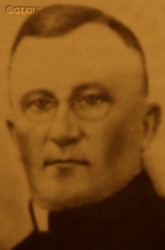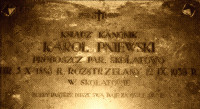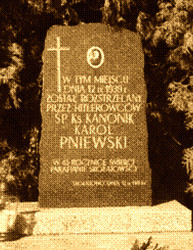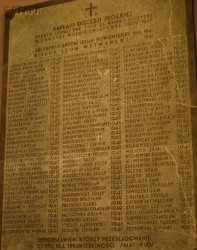Roman Catholic
St Sigismund parish
05-507 Słomczyn
85 Wiślana Str.
Konstancin deanery
Warsaw archdiocese, Poland
full list:
displayClick to display full list

searchClick to search full list by categories
wyświetlKliknij by wyświetlić pełną listę po polsku

szukajKliknij by przeszukać listę wg kategorii po polsku

Martyrology of the clergy — Poland
XX century (1914 – 1989)
personal data
surname
PNIEWSKI
forename(s)
Charles Henry (pl. Karol Henryk)
function
diocesan priest
creed
Latin (Roman Catholic) Church RCmore on
en.wikipedia.org
[access: 2014.09.21]
diocese / province
Płock diocesemore on
en.wikipedia.org
[access: 2013.05.19]
honorary titles
honorary canonmore on
honorary canon (Annunciation to the Blessed Virgin Mary RC collegiate church, Pułtusktoday: Pułtusk gm., Pułtusk pov., Masovia voiv., Poland
more on
en.wikipedia.org
[access: 2021.12.18])
date and place
of death
12.09.1939

Skołatowotoday: Dzierzążnia gm., Płońsk pov., Masovia voiv., Poland
more on
en.wikipedia.org
[access: 2021.12.18]
details of death
On 10.09.1939 Skołatowo was captured by the Germans who attacked Poland on 01.09.1939 (Russians invaded Poland 17 days later) and started World War II.
Two days later murdered by German soldiers.
Dragged out of his rectory and taken to the cemetery wall.
There 2,5 m from the fence took his hat off, clasped his hands, raised them up to the eye level and having his mother's grave and a tall cross in front of him started to pray.
German soldier shot him in his head.
cause of death
murder
perpetrators
Germans
sites and events
«Intelligenzaktion»Click to display the description, Ribbentrop‐MolotovClick to display the description, Pius XI's encyclicalsClick to display the description
date and place
of birth
05.11.1886

Pniewo Wielkietoday: Regimin gm., Ciechanów pov., Masovia voiv., Poland
more on
en.wikipedia.org
[access: 2022.01.28]
parents
PNIEWSKI John
🞲 ?, ? — 🕆 ?, ?

DZILIŃSKA Lucyna
🞲 ?, ? — 🕆 ?, ?
baptism
07.11.1886

Lekowotoday: Regimin gm., Ciechanów pov., Masovia voiv., Poland
more on
en.wikipedia.org
[access: 2021.12.18]
St Stanislav the Bishop and Martyr RC church
presbyter (holy orders)
ordination
24.06.1909

Płocktoday: Płock city pov., Masovia voiv., Poland
more on
en.wikipedia.org
[access: 2021.12.18]
Assumption of the Blessed Virgin Mary RC cathedral churchmore on
en.wikipedia.org
[access: 2025.03.14]
positions held
1918 – 1939
parish priest — Skołatowotoday: Dzierzążnia gm., Płońsk pov., Masovia voiv., Poland
more on
en.wikipedia.org
[access: 2021.12.18] ⋄ St Acathius RC parish ⋄ Płońsktoday: Płońsk urban gm., Płońsk pov., Masovia voiv., Poland
more on
en.wikipedia.org
[access: 2021.12.18] RC deanery
1909 – 1918
vicar — Pułtusktoday: Pułtusk gm., Pułtusk pov., Masovia voiv., Poland
more on
en.wikipedia.org
[access: 2021.12.18] ⋄ Annunciation to the Blessed Virgin Mary RC collegiate church ⋄ St Matthew the Apostle and the Evangelist RC parish ⋄ Pułtusktoday: Pułtusk gm., Pułtusk pov., Masovia voiv., Poland
more on
en.wikipedia.org
[access: 2021.12.18] RC deanery
1903 – 1909
student — Płocktoday: Płock city pov., Masovia voiv., Poland
more on
en.wikipedia.org
[access: 2021.12.18] ⋄ philosophy and theology, Theological Seminary
sites and events
descriptions
«Intelligenzaktion»: (Eng. „Action Intelligentsia”) — extermination program of Polish elites, mainly intelligentsia, executed by the Germans right from the start of the occupation in 09.1939 till around 05.1940, mainly on the lands directly incorporated into Germany but also in the so‐called Germ. Generalgouvernement (Eng. General Governorate) where it was called «AB‐aktion». During the first phase right after start of German occupation of Poland implemented as Germ. Unternehmen „Tannenberg” (Eng. „Tannenberg operation”) — plan based on proscription lists of Poles worked out by (Germ. Sonderfahndungsbuch Polen), regarded by Germans as specially dangerous to the German Reich. List contained names of c. 61,000 Poles. Altogether during this genocide Germans methodically murdered c. 50,000 teachers, priests, landowners, social and political activists and retired military. Further 50,000 were sent to concentration camps where most of them perished. (more on: en.wikipedia.orgClick to attempt to display webpage
[access: 2014.10.04])
Ribbentrop‐Molotov: Genocidal Russian‐German alliance pact between Russian leader Joseph Stalin and German leader Adolf Hitler signed on 23.08.1939 in Moscow by respective foreign ministers, Mr. Vyacheslav Molotov for Russia and Joachim von Ribbentrop for Germany. The pact sanctioned and was the direct cause of joint Russian and German invasion of Poland and the outbreak of the World War II in 09.1939. In a political sense, the pact was an attempt to restore the status quo ante before 1914, with one exception, namely the „commercial” exchange of the so‐called „Kingdom of Poland”, which in 1914 was part of the Russian Empire, fore Eastern Galicia (today's western Ukraine), in 1914 belonging to the Austro‐Hungarian Empire. Galicia, including Lviv, was to be taken over by the Russians, the „Kingdom of Poland” — under the name of the General Governorate — Germany. The resultant „war was one of the greatest calamities and dramas of humanity in history, for two atheistic and anti‐Christian ideologies — national and international socialism — rejected God and His fifth Decalogue commandment: Thou shall not kill!” (Abp Stanislav Gądecki, 01.09.2019). The decisions taken — backed up by the betrayal of the formal allies of Poland, France and Germany, which on 12.09.1939, at a joint conference in Abbeville, decided not to provide aid to attacked Poland and not to take military action against Germany (a clear breach of treaty obligations with Poland) — were on 28.09.1939 slightly altered and made more precise when a treaty on „German‐Russian boundaries and friendship” was agreed by the same murderous signatories. One of its findings was establishment of spheres of influence in Central and Eastern Europe and in consequence IV partition of Poland. In one of its secret annexes agreed, that: „the Signatories will not tolerate on its respective territories any Polish propaganda that affects the territory of the other Side. On their respective territories they will suppress all such propaganda and inform each other of the measures taken to accomplish it”. The agreements resulted in a series of meeting between two genocidal organization representing both sides — German Gestapo and Russian NKVD when coordination of efforts to exterminate Polish intelligentsia and Polish leading classes (in Germany called «Intelligenzaktion», in Russia took the form of Katyń massacres) where discussed. Resulted in deaths of hundreds of thousands of Polish intelligentsia, including thousands of priests presented here, and tens of millions of ordinary people,. The results of this Russian‐German pact lasted till 1989 and are still in evidence even today. (more on: en.wikipedia.orgClick to attempt to display webpage
[access: 2015.09.30])
Pius XI's encyclicals: Facing the creation of two totalitarian systems in Europe, which seemed to compete with each other, though there were more similarities than contradictions between them, Pope Pius XI issued in 03.1937 (within 5 days) two encyclicals. In the „Mit brennender Sorge” (Eng. „With Burning Concern”) published on 14.03.1938, condemned the national socialism prevailing in Germany. The Pope wrote: „Whoever, following the old Germanic‐pre‐Christian beliefs, puts various impersonal fate in the place of a personal God, denies the wisdom of God and Providence […], whoever exalts earthly values: race or nation, or state, or state system, representatives of state power or other fundamental values of human society, […] and makes them the highest standard of all values, including religious ones, and idolizes them, this one […] is far from true faith in God and from a worldview corresponding to such faith”. On 19.03.1937, published „Divini Redemptoris” (Eng. „Divine Redeemer”), in which criticized Russian communism, dialectical materialism and the class struggle theory. The Pope wrote: „Communism deprives man of freedom, and therefore the spiritual basis of all life norms. It deprives the human person of all his dignity and any moral support with which he could resist the onslaught of blind passions […] This is the new gospel that Bolshevik and godless communism preaches as a message of salvation and redemption of humanity”… Pius XI demanded that the established human law be subjected to the natural law of God , recommended the implementation of the ideal of a Christian state and society, and called on Catholics to resist. Two years later, National Socialist Germany and Communist Russia came together and started World War II. (more on: www.vatican.vaClick to attempt to display webpage
[access: 2023.05.28], www.vatican.vaClick to attempt to display webpage
[access: 2023.05.28])
sources
personal:
skolatowo.ugu.plClick to attempt to display webpage
[access: 2013.05.19], www.plonszczak.plClick to attempt to display webpage
[access: 2015.05.09], metryki.genealodzy.plClick to attempt to display webpage
[access: 2025.03.16]
bibliographical:
„Płock diocese clergy martyrology during II World War 1939‐1945”, Fr Nicholas Marian Grzybowski, Włocławek–Płock 2002
original images:
skolatowo.ugu.plClick to attempt to display webpage
[access: 2013.05.19], skolatowo.ugu.plClick to attempt to display webpage
[access: 2013.05.19], skolatowo.ugu.plClick to attempt to display webpage
[access: 2013.05.19]
LETTER to CUSTODIAN/ADMINISTRATOR
If you have an Email client on your communicator/computer — such as Mozilla Thunderbird, Windows Mail or Microsoft Outlook, described at WikipediaPatrz:
en.wikipedia.org, among others — try the link below, please:
LETTER to CUSTODIAN/ADMINISTRATORClick and try to call your own Email client
If however you do not run such a client or the above link is not active please send an email to the Custodian/Administrator using your account — in your customary email/correspondence engine — at the following address:

giving the following as the subject:
MARTYROLOGY: PNIEWSKI Charles Henry
To return to the biography press below:
 Click to return to biography
Click to return to biography












